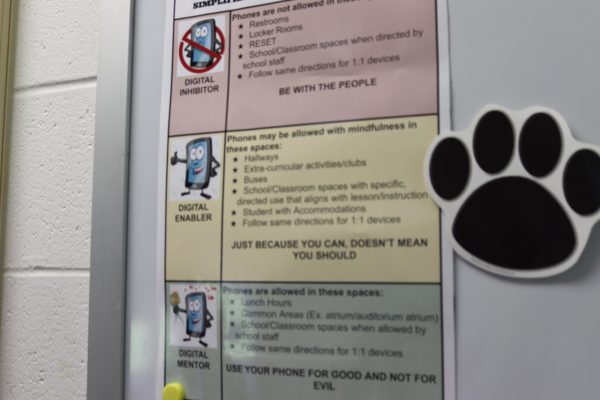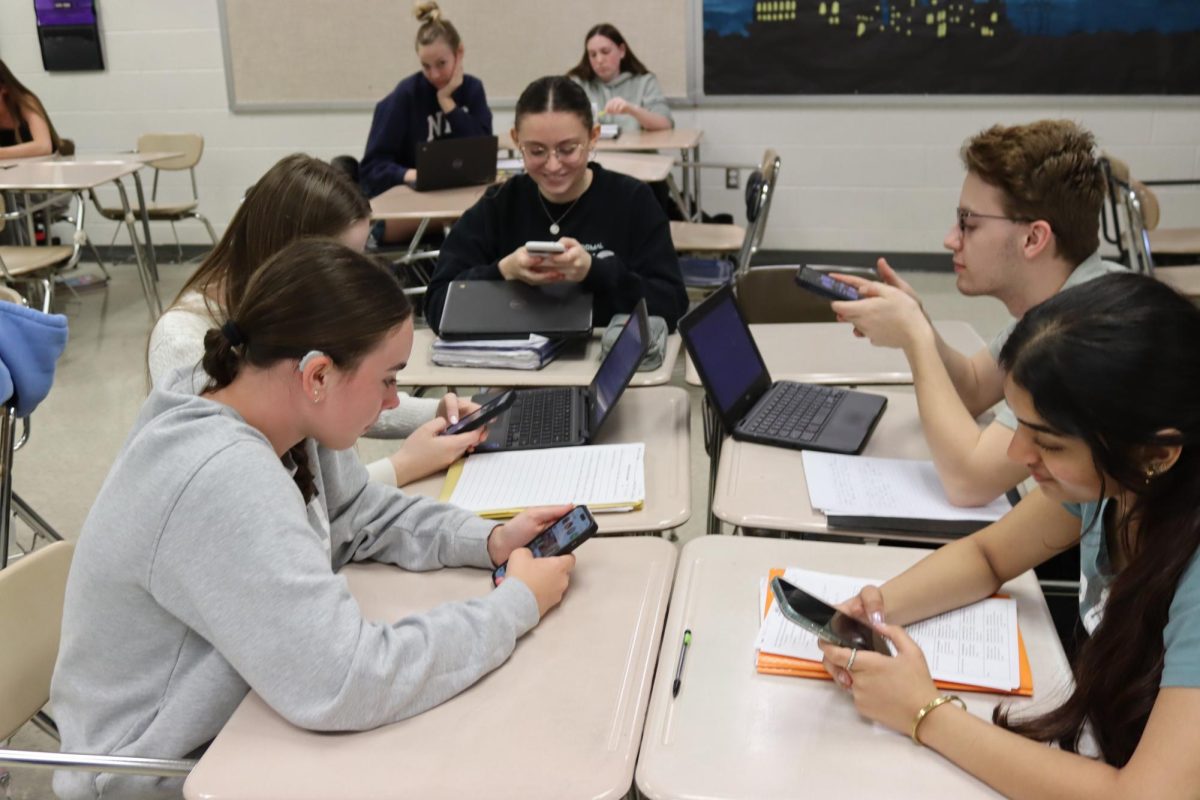In light of the Illinois House committee approving a cell phone ban bill to move further through the legislative process, Normal West looks at what a stricter cell phone policy would look like for its students and staff.
Educators across the nation are facing a growing cell phone problem.
There is serious, developing concern and subsequent research about the attention span of students and how their learning is being affected by screens.
Educators will continue to have to expand their job positions and likely teach skills outside of the curriculum as the generation adapts to increased technology use.
“I think we’re experiencing a fundamental difference in how we think and interact with other people,” chemistry teacher Jessica King added. “I’ve noticed students have decreasing faith in their ability to do things on their own.”
Normal West’s current phone regulation policy is the “Red Zone, Yellow Zone and Green Zone” system, where teachers designate the times during class that students are allowed to have their phones and when they need to be present in learning.
Teachers have applied this policy in different ways across different age level classes.
“In my honors classes, for younger students, we started the year where people had to put their phones in their backpacks and people had to move their backpacks to the edge of the room,” King shared.
“It worked reasonably well, but students needed other things out of their bag and it became disruptive, [but] second semester started to use the cell phone tree and that has worked well.”
A cell phone ban is not unfamiliar to the Central Illinois area. Peoria Public Schools and District 87 are implementing cell phone bans, where students are only allowed to be on their phones before school, after school and during lunch.
While no official plan has been set in stone for Unit 5 yet, students can expect a change in approach to cell phone use in the classroom for the 2025-2026 school year.
West Principal, Dr. Angie Codron recognizes the need for cell phone regulation and has watched the neighboring schools as they’ve tried various regulatory processes. Peoria Public Schools, for example, purchased Yondr pouches for their students this past school year.
The goal of any phone ban is to ultimately teach students self regulation and how to manage an inherently addictive behavior.
Although no official action has been taken, at the April 16 Unit 5 board meeting, the committee reported their recommendations to the school board as follows:
- Elementary students should have cell phones off or on silent and put away in backpacks
- Junior high students should have them silent and away at all times during the day, including lunch and in the hallways.
- High school students should have them silent and away unless given permission by a staff member or in an identified area/time where a cell phone is permitted.
If these recommendations remain, West’s current cell phone policy will remain; however, a look at a tighter grasp on the zones may be necessary.
Codron states that Normal West’s current “red, yellow, green policy” is working, but tiers of

(Jack Hanks)
interventions need to be established.
“We have school data that shows that by using red, yellow, and green zones for phones to help with usage during educational purposes our cell phone referrals have gone from 3rd on the list of offenses to 5th on the list of offenses…,” Codron noted.
Codron notes that administrative interventions/consequences need to be more clearly outlined to help with the phone zone enforcement once it is clear that a student is showing a pattern of behavior with their phone.
There are also plans to have more specific interventions through MTSS (multi-tiered systems of support).
“We have several school teams that will be working on this tiered approach to the top incidents, including cell phone usage, at Normal West to roll out for next school year,” Codron explained.
A Unit 5 task force made up of administrators and staff across the district have been working on data and research all school year in order to find the best approach for students and staff in each grade level.
“When it’s a yellow zone I’m hoping students can self manage and stay on task, or maybe be willing to turn off notifications during the day to help give their mind a break for their phone,” Codron shared.
“Phones are still available to students if we better define and follow our red, yellow and green zones to students.”
Regardless of any decision, there will be push back from students and parents. One reason being the possible lack of contact between students and parents in an emergency.
However, phones are also proven to not be entirely detrimental to the classroom environment and frequently are used as a tool.
“There is a practical part of using phones within the educational environment that I have seen,” Codron shared.
“For example, playing Kahoot or Blookit, using phones as calculators, using phones to video a lab, take pictures of notes on the board, etc,” she added.
Codron worries that locking phones away might prove to be a disadvantage in these classroom settings.
“I worry that when a chromebook is not working properly that a ban, like some schools have done with a phone in a magnetic pouch, or phones in a secure and accessible lock box each class hour, would not allow phones to be used as a secondary device…and would take away from instructional time as students secure and unsecure devices,” Codron stated.
However, Codron also acknowledges the adverse effects of social media and instant access to the internet on students.
“I am aware of the effects social media has on our teenagers. I have many conversations about social media with our students when they come to me concerned about anonymous sites, posts, etc,” Codron noted.
“Managing social media is a life skill and again, we are teachers at heart so I think teaching young people how to manage this is part of what we are here for as educators,” she continued.
Because of the cell phone policies King has implemented in her classroom, she has seen an improvement in her students behavior and attitudes towards their phones and schoolwork.
“We’ve gotten to the point where students are asking when there’s a reasonable time to use their phone. I’m pretty happy with that because students are learning the appropriate time to use their phones,” King added.
With regards to the following school year, Codron believes, “we do have a good plan in place to help our students navigate their mobile devices.”
In order for a shift in cell phone policy, the school needs to commit to one strategy that is consistent throughout the building, according to King.
“I took a class on cell phone use in school this semester and it was reiterated that there has to be a school-wide policy that is enforced by every single teacher consistently,” King noted.
The 2025-26 school might look different for current high school students, but West plans to take action to better the classroom environment.













